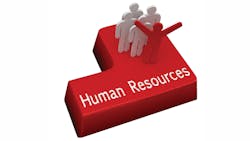People Power: Job Benchmarking
When coaching business managers and business owners, I often hear the same lament: “We are having serious performance issues. We hired workers, and we are having nothing but trouble with them! They are just not right for the job.” It brings to mind a phrase I came across many years ago — “We sought workers...but people came instead.”
When I share this statement, I typically get a somewhat quizzical look. I assure the manager/owner that what they are experiencing is a common complaint and explain that the issue is “workers” vs. “people.”
Just filling positions eagerly or filling them carelessly with warm bodies (workers) rather than thoughtfully filling them with individuals (people) is the problem. Not filling positions with people who are shown to have the talents to be well-suited for a particular position will absolutely result in performance issues.
Your company should have a process in place for finding and acquiring the specific talents that are needed for each position. If you do not have such a process, you run the risk of square peg/round hole syndrome.
Job Benchmarking
The first step in establishing how to identify the right people is defining the job. Once that is accomplished, you can determine the type of person who will succeed in it. This process goes well beyond having a job description, which is just the starting point.
Knowing what education, experience and technical skills are required is important; however, a job benchmark goes well beyond it — capturing the key performance factors unique to a position. It will clearly define what you expect the job to accomplish.
Job benchmarking identifies the performance characteristics, drivers and personal skills that are required for top performance. It gets to what is vital in order for success to be achieved in the position. Use the philosophy “if the job could talk” and ask what it would say about the talents a candidate must possess in order to excel. Matching candidate attributes with job requirements is essential to promoting/hiring “right person, right job.”
Combining a job benchmark with the use of validated pre-employment assessments will enable you to evaluate candidates and directly compare them to what is required for successful job performance.
Proper selection can eliminate 90 percent of future performance problems and reduce the time managers must devote to dealing with issues. If people are put into a position where they can do things in the ways they prefer to behave, work on things that they find rewarding and use skills that they already possess, they will “get it done.” Then, all managers have to do is mutually determine what needs to be accomplished, what results are expected, timelines and then get out of their way. The employee will be self-motivated to excel!
How effective is your organization in selecting top performers? Are you consistently hiring in ways that ensure good “job fit?” For a complimentary report reflecting your performance characteristics, drivers and personal skills, please contact [email protected]. In addition to the we will gladly provide you with a debriefing of the insights in the report.
Ted Szaniawski is founder and Principal of HRGroup, a provider of Human Resource support services, including hiring practices, compensation programs, talent development and more. For additional info, or to suggest a topic for a future article, please email [email protected].
Sidebar
Understanding Talents
Identify the talents a person will bring to the job and compare their talents to job requirements before you hire or promote them.
Performance Characteristics: Measure how a person will behave and perform in a work environment, including how they:
- Respond to problems and challenges
- Influence other to their point of view
- Respond to the pace of the environment
- Respond to rules and procedures set my others
Drivers: Understand a person’s motivating factors. Are they rewarded by:
- Gathering knowledge and intellectual growth
- Practical accomplishments and achieving results and ROI
- Personal recognition and control over their destiny and ohers
- Opportunities to be of service contribute to the wellbeing of others
- Balance in their lives, creative self-expression and beauty
- Traditions, structure, rules and regulations
Personal Skills: Learn how well-developed a person is in 23 “soft skills” such as:
- Decision Making
- Planning/Organizing
- Teamwork
- Analytical Problem Solving
- Leadership
- Self-management (time and priorities)
- Plus 17 additional personal skills
